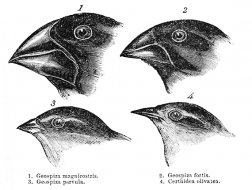 Today's entry was written by Thomas Burnett. You can read more about what we believe here.
Today's entry was written by Thomas Burnett. You can read more about what we believe here.
Note: Not only are evolution and biblical faith compatible, but committed Christians have been at the forefront of evolutionary science ever since Darwin published On the Origin of Species in 1859. This week we'll examine the lives of two devout Christians—David Lack and Asa Gray—who each made an enduring impact on modern biology. Today we feature the first of two posts on British ornithologist David Lack.
Darwin’s Finches?
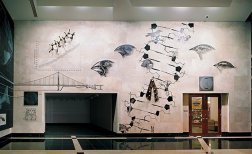 Darwin’s finches are some of the most visible and recognizable symbols of evolution in the world today. Biology textbooks feature them prominently, and the National Academy of Sciences has enshrined them in the entrance of their headquarters in Washington, DC. Surely the finches that Darwin collected on the Galápagos islands were a central feature of his evolutionary theory, right?
Darwin’s finches are some of the most visible and recognizable symbols of evolution in the world today. Biology textbooks feature them prominently, and the National Academy of Sciences has enshrined them in the entrance of their headquarters in Washington, DC. Surely the finches that Darwin collected on the Galápagos islands were a central feature of his evolutionary theory, right?
Lobby of The National Academies Building. Courtesy of CPNAS. Photo by Robert Lautman
Actually, the Galápagos finches are never even mentioned in Darwin’s famous work On the Origin of Species.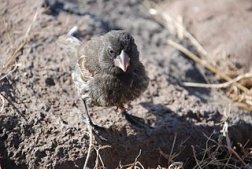 assing.2
assing.2
It was only in 1845, in the second edition of The Voyage of the Beagle, that Darwin included a tantalizing sentence about the Galápagos finches:
Seeing this gradation and diversity of structure in one small, intimately related group of birds, one might really fancy that from an original paucity of birds in this archipelago, one species had been taken and modified for different ends.3However insightful this statement may have been, Darwin never published anything else about the Galápagos finches for the rest of his life. Nor did he publically present these birds as direct evidence for this theory of evolution.4
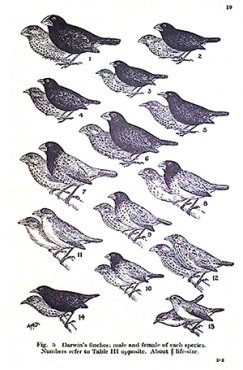 If these finches were so important to Darwin’s evolutionary theory, why did he remain silent about them? One of his comments in The Voyage of the Beagle provides us with a clue:
If these finches were so important to Darwin’s evolutionary theory, why did he remain silent about them? One of his comments in The Voyage of the Beagle provides us with a clue:
When Darwin was exploring the Galápagos himself in 1835, he had not formulated his theory of evolution yet, and thus he did know what data would be necessary to make definitive conclusions about finch evolution. In particular, he did not keep careful track of which of his specimens came from which islands. Moreover, as was customary among naturalists at that time, Darwin only collected a small number specimens—he brought home only 31 finches and 64 total birds from the Galápagos.6








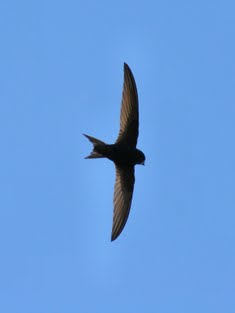 David Lambert Lack FRS, (16 July 1910 – 12 March 1973) was a British evolutionary biologist who made contributions to ornithology, ecology and ethology. His book on the finches of the Galapagos Islands was a landmark work.
David Lambert Lack FRS, (16 July 1910 – 12 March 1973) was a British evolutionary biologist who made contributions to ornithology, ecology and ethology. His book on the finches of the Galapagos Islands was a landmark work.